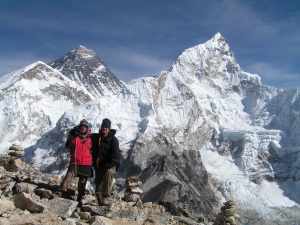
update reports pictures
report 25 report 28
home
velotour 2004-2007
contact

update
reports
pictures
report 25
report 28

|
Now reckoned to be 8844,43 m, Mt. Everest is the highest mountain on our planet and consequently irresistible centre of attraction for adventurers and extreme sportsmen and sportswomen. Since Sir Edmund Hillary and Tenzing Norgay first climbed to the summit in the 1953, some 2500 people have conquered the summit, among them a man of 70, a blind man, and a man with an artificial leg. About 200 mountaineers have died trying to reach the summit.
On 22nd of November we reached the base camp of Mt. Everest, and had difficulty breathing. Only half of the oxygen found at sea level is available in this height. At 5400m it is already 600m higher as the highest mountain in Europe Mt. Blanc. During spring it is possible to climb to the summit of Mt. Everest. During this period base camp temporarily develops into a lively town of about 300 tents with expeditions from all countries in the world. We were here in November and nobody was trying to climb the mountain so the camp was deserted. Nothing except 2 wrecks of helicopters mark the place and show the difficulities pilots have manoeuvring in these altitudes.
In the village of Jiri the road ends and the trek to the base camp of Mt. Everest begins. We needed 29 days and had to climb altogether 32000 metres. The trek winds over the mountains like a roller coaster and ends at the base camp. This is the only way to the base camp and consequently we had to walk the same way back. Most of the hikers and expeditions fly to the village of Lukla with an aeroplane to shorten the trek to the half of the distance. But comfort is not the only reason for the flight. From Lukla to the base camp of Mt. Everest the Nepalese army controls the area to make it safe for tourists. But on the first part of the trek there is no army and Maoists (political rebels) terrorize tourists and also local people. In 1996 the Maoists gave up their parliamentary cooperation and begun their armed "fight for independence". They demanded the abolition of the monarchy, and are cold-blooded murderers. They have killed more than 9000 people in Nepal.

|
On our third day, after crossing a high pass we actually met some of these Communist rebels in a little village called Bandhar. In the morning they stood at the edge of the path and demanded a fee of 5000 rupies (about 57 Euro) for one person, in order to continue our trek. We bargained, and in the end we had to pay only the half of the money. They gave us a "ticket", but we felt very unhappy about supporting this violent revolution with our money. However we clearly saw aggression in the eyes of the rebels. Moreover they had weapons, and we knew, that they would't hesitate to use them against us. One day before in a village before Bandhar, we met two policewomen from Switzerland. They refused to pay any money for a couple of days. After 3 days the women gave up, because the Maoists kept following them with their weapons, and forced their way into the hotel room and threatened the women with their firearms. The women didn't want to pay the fee and walked the whole way back. Not only rich tourists, but also poor people such as hoteliers and sherpas have to pay money to the Maoists. The rebels call this "revolution taxes". From this money they buy also new weapons. These weapons reinforce the violence in the country. Since 1996 fewer and fewer tourists have been coming into the country and nobody knows when the conflict will come to an end. andreaslina(at)yahoo.de